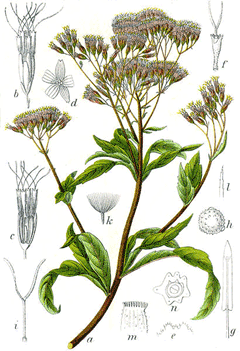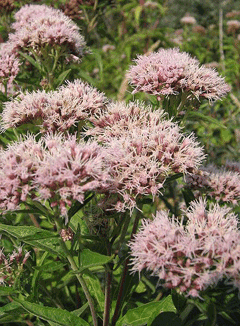 |
|
http://commons.wikimedia.org/wiki/File:Eupatorium_cannabinum_Sturm4.jpg |
 |
| http://commons.wikimedia.org/wiki/User:Svdmolen |
Translate this page:
Summary
Physical Characteristics

 Eupatorium cannabinum is a PERENNIAL growing to 1.5 m (5ft) by 1 m (3ft 3in).
Eupatorium cannabinum is a PERENNIAL growing to 1.5 m (5ft) by 1 m (3ft 3in).
See above for USDA hardiness. It is hardy to UK zone 5 and is not frost tender. It is in flower from July to September, and the seeds ripen from August to October. The species is hermaphrodite (has both male and female organs) and is pollinated by Bees, flies, beetles, Lepidoptera (Moths & Butterflies). The plant is self-fertile.
It is noted for attracting wildlife.
Suitable for: light (sandy), medium (loamy) and heavy (clay) soils. Suitable pH: mildly acid, neutral and basic (mildly alkaline) soils. It can grow in semi-shade (light woodland) or no shade. It prefers moist or wet soil.
UK Hardiness Map
US Hardiness Map
Synonyms
Plant Habitats
Woodland Garden Dappled Shade; Shady Edge; Bog Garden;
Edible Uses
References More on Edible Uses
Medicinal Uses
Plants For A Future can not take any responsibility for any adverse effects from the use of plants. Always seek advice from a professional before using a plant medicinally.
Alterative Antitumor Cholagogue Depurative Diaphoretic Diuretic Emetic Expectorant
Febrifuge Homeopathy Laxative Purgative Tonic
Hemp agrimony has been employed chiefly as a detoxifying herb for fevers, colds, flu and other viral conditions. It also stimulates the removal of waste products via the kidneys[254]. Due to its content of alkaloids, the plant should only be used under professional supervision[254]. The leaves and flowering tops are alterative, cholagogue, depurative, diuretic, emetic, expectorant, febrifuge, purgative and tonic[4, 7, 9, 21, 46, 238]. The plant has a long history of use as a gentle laxative that does not provoke irritation[7], though excessive doses cause purging and vomiting[238]. A tea made from the dried leaves will give prompt relief if taken at the onset of influenza[4]. Recent research has shown that the plant might have anti-tumour activity, though the plant also contains pyrrolizidine alkaloids that can cause damage or cancer to the liver[238]. The plant is harvested in the summer and dried for later use[7]. The roots are diaphoretic, laxative and tonic[7]. They are harvested in the autumn and dried for later use[238]. Recently the plant has been found of use as an immune system stimulant, helping to maintain resistance to acute viral and other infections[254]. A homeopathic remedy is made from the leaves[4]. It is used in the treatment of influenza and feverish chills[4] and also for disorders of the liver, spleen and gall bladder[9].
References More on Medicinal Uses
The Bookshop: Edible Plant Books
Our Latest books on Perennial Plants For Food Forests and Permaculture Gardens in paperback or digital formats.

Edible Tropical Plants
Food Forest Plants for Hotter Conditions: 250+ Plants For Tropical Food Forests & Permaculture Gardens.
More

Edible Temperate Plants
Plants for Your Food Forest: 500 Plants for Temperate Food Forests & Permaculture Gardens.
More

More Books
PFAF have eight books available in paperback and digital formats. Browse the shop for more information.
Shop Now
Other Uses
References More on Other Uses
Cultivation details
An easily grown plant[233], it succeeds in ordinary garden soil in sun or part shade[200]. Prefers a rich moist soil[187]. Grows well in marshy soils[21]. Plants are hardy to about -25°c[187]. A very ornamental plant[1], it has a pleasant aromatic smell when cut[4]. Often found as a weed in British gardens, it can be allowed to naturalize in short grass in the wild garden[233]. Plants seem to be immune to the predations of rabbits[233]. An excellent bee and butterfly plant[24, 108].
References Carbon Farming Information and Carbon Sequestration Information
Temperature Converter
Type a value in the Celsius field to convert the value to Fahrenheit:
Fahrenheit:
The PFAF Bookshop
Plants For A Future have a number of books available in paperback and digital form. Book titles include Edible Plants, Edible Perennials, Edible Trees,Edible Shrubs, Woodland Gardening, and Temperate Food Forest Plants. Our new book is Food Forest Plants For Hotter Conditions (Tropical and Sub-Tropical).
Shop Now
Plant Propagation
Seed - sow spring in a cold frame and only just cover the seed. Prick out the seedlings into individual pots when they are large enough to handle and plant them out into their permanent positions in the summer. If you have sufficient seed it can be sown outdoors in situ. Division in spring or autumn[111]. Very easy, the clumps can be replanted direct into their permanent positions.
Other Names
If available other names are mentioned here
Native Range
TEMPERATE ASIA: Cyprus, Iran, Iraq (north), Israel, Lebanon, Syria, Turkey, Russian Federation-Ciscaucasia (Ciscaucasia), Armenia, Azerbaijan, Georgia, Russian Federation (Dagestan), Turkmenistan TROPICAL ASIA: Nepal EUROPE: Denmark, Finland, United Kingdom, Ireland, Norway, Sweden, Austria, Belgium, Switzerland, Czech Republic, Germany, Hungary, Netherlands, Poland, Slovakia, Russian Federation (European part), Belarus, Estonia, Lithuania, Latvia, Moldova, Ukraine (incl. Krym), Albania, Bulgaria, Bosnia and Herzegovina, Greece, Croatia, Italy (incl. Sardinia, Sicily), North Macedonia, Montenegro, Romania, Serbia, Slovenia, Spain, France (incl. Corsica), Portugal AFRICA: Algeria, Morocco
Weed Potential
Right plant wrong place. We are currently updating this section.
Please note that a plant may be invasive in one area but may not in your area so it's worth checking.
Conservation Status
IUCN Red List of Threatened Plants Status :

Growth: S = slow M = medium F = fast. Soil: L = light (sandy) M = medium H = heavy (clay). pH: A = acid N = neutral B = basic (alkaline). Shade: F = full shade S = semi-shade N = no shade. Moisture: D = dry M = Moist We = wet Wa = water.
Now available:
Food Forest Plants for Mediterranean Conditions
350+ Perennial Plants For Mediterranean and Drier Food Forests and Permaculture Gardens.
[Paperback and eBook]
This is the third in Plants For A Future's series of plant guides for food forests tailored to
specific climate zones. Following volumes on temperate and tropical ecosystems, this book focuses
on species suited to Mediterranean conditions—regions with hot, dry summers and cool, wet winters,
often facing the added challenge of climate change.
Read More
Expert comment
Author
L.
Botanical References
17200
Links / References
For a list of references used on this page please go here
Readers comment